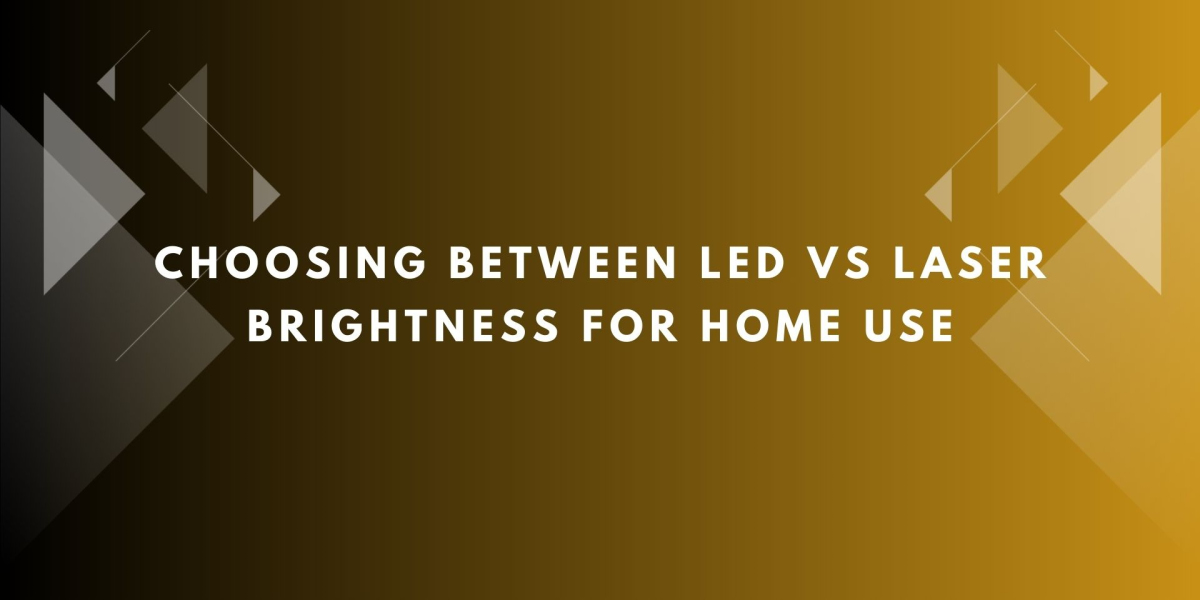Home projectors have become increasingly popular in recent years, transforming living rooms, home theaters, and even bedrooms into cinematic experiences. When selecting a projector, brightness is one of the most critical factors to consider. Brightness affects how clear and vibrant the image appears and influences viewing comfort. Two of the most common technologies used in home projectors today are LED and laser. Each has its unique advantages and considerations, especially when it comes to brightness and overall image quality. This blog will help you understand the differences between LED and laser projectors and guide you in choosing the right option for home use.
Understanding LED and Laser Projectors
LED Projectors
LED projectors use light-emitting diodes as the light source. They are known for being energy-efficient, compact, and long-lasting. LEDs produce consistent brightness and color, making them suitable for smaller rooms or areas with controlled lighting. LED projectors generally have lower lumen ratings than laser projectors, but their efficiency often compensates for this in home environments.
Laser Projectors
Laser projectors use a laser light source to project images. Lasers produce a brighter and sharper image compared to LED, making them ideal for larger screens or rooms with ambient light. Laser projectors are also known for excellent color accuracy and contrast ratios. They tend to have higher lumen ratings, which means the image remains clear even in well-lit spaces. However, laser projectors are usually more expensive and may require more space due to cooling needs.
Comparing Brightness: LED vs Laser
Lumens and Perceived Brightness
Lumens measure the total light output of a projector. Laser projectors typically offer higher lumen ratings than LED models, ranging from 2000 to over 5000 lumens for home use. LED projectors usually range between 800 and 3000 lumens. While lumens give a quantitative measure of brightness, perceived brightness also depends on screen size, room lighting, and projection distance. In a darkened home theater, an LED projector with lower lumens can still deliver a clear and immersive image.
Screen Size Considerations
LED projectors perform best with smaller screens or when viewers are close to the display. A 70 to 100-inch screen can look bright and sharp with a 1500 to 2000 lumen LED projector in a controlled environment. Laser projectors, with higher brightness, are better suited for larger screens over 120 inches or rooms where ambient light cannot be fully controlled.
Ambient Light Performance
One of the main advantages of laser projectors is their ability to maintain brightness in rooms with ambient light. LED projectors, while efficient, may struggle to deliver a vibrant image if sunlight or indoor lighting is present. For living rooms or spaces with large windows, a laser projector is usually the preferred choice.
Color Accuracy and Contrast
Both LED and laser projectors offer excellent color performance, but lasers generally provide superior contrast ratios. High contrast makes dark scenes more detailed and bright scenes more impactful. LED projectors may have slightly lower contrast, but their colors remain vibrant, especially in small to medium home theaters.
Energy Efficiency and Longevity
LED projectors are highly energy-efficient and can last 20,000 to 30,000 hours without replacing the light source. Laser projectors also offer long lifespans, often exceeding 20,000 hours, but they consume more power to achieve higher brightness. Both technologies significantly outperform traditional lamp projectors in terms of maintenance and cost over time.
Cost Considerations
LED projectors are generally more affordable and accessible for typical home setups. Laser projectors, due to higher brightness and performance capabilities, tend to be more expensive. When budgeting for a home theater, it is important to weigh the need for brightness against cost. Smaller rooms with controlled lighting may not require the higher brightness of a laser projector, making an LED projector a cost-effective choice.
Choosing the Right Projector for Your Home
Room Size and Lighting
If you have a small to medium room with controlled lighting, an LED projector with 1500 to 2500 lumens may suffice. For larger rooms, living areas with ambient light, or if you plan to use a larger screen, a laser projector with 3000 to 5000 lumens or more is recommended.
Screen Size
Determine the size of the screen you plan to use. LED projectors perform best with screens under 120 inches. Laser projectors excel on larger screens and can maintain clarity over wider viewing angles.
Usage Preferences
Consider how you will use the projector. For movie nights in a darkened room, an LED projector can deliver excellent performance. For daytime viewing, gaming, or mixed-use spaces, laser projectors offer the brightness needed to handle varying lighting conditions.
Budget
LED projectors are ideal for those looking for a budget-friendly option with low maintenance and long lifespan. Laser projectors require a higher upfront investment but provide superior brightness and performance for demanding home theater setups.
Conclusion
Choosing between LED and laser projectors for home use comes down to balancing brightness, room conditions, screen size, and budget. LED projectors offer energy efficiency, vibrant colors, and long lifespan, making them ideal for smaller, controlled environments. Laser projectors provide higher brightness, better contrast, and excellent performance in rooms with ambient light, making them suitable for larger screens and versatile viewing conditions.
XTEN-AV provides guidance and solutions to help homeowners select the right projector technology for their needs. By understanding the differences between LED and laser brightness, you can create a home theater experience that delivers clear, vibrant, and immersive visuals for movies, gaming, and interactive media.
Read more: https://logcla.com/blogs/843440/Comparing-Projector-Brightness-for-Dark-vs-Bright-Rooms








